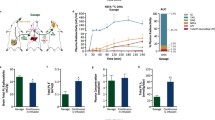Abstract
Interorgan variation in tissue distribution of weakly basic drugs such as quinidine, propranolol, and imipramine was investigated as a function of binding to phosphatidylserine (PhS) in tissues. Tissue distributions of these drugs were determined using 10 different tissues at a steady-state plasma concentration and were expressed as tissue-to-plasma partition coefficients (K p values). The concentration of PhS in the tissue was determined by two-dimensional thin-layer chromatography. Plotting of K p values, except for brain, against the tissue PhS concentrations showed a linear relationship, indicating that PhS is a determinant in the interorgan variation of these tissue distributions. Further, differences in tissue distribution among the drugs was considered to be due to the difference in binding potency to PhS. Drug binding parameters to individual standard phospholipid were determined using a hexane-pH 4.0 buffer partition system. Binding was highest to PhS, and a linear relationship was found between the log nK [product of the number of binding sites (n) and the association constant (K) for PhS binding] obtained in vitro and K p values of drugs in tissues in vivo. The empirically derived equation, K p = 14.3 × (log nK) × (PhS cone.) − 8.09, was found to predict K p values in vivo of weakly basic drugs. Thus, a determinant of interorgan variation in the tissue distribution of the weakly basic drugs studied was the tissue concentration of PhS and the drug binding affinity to PhS.
Similar content being viewed by others
REFERENCES
T. Terasaki, T. Iga, Y. Sugiyama, and M. Hanano. J. Pharm. Pharmacol. 34:597–600 (1982).
T. Terasaki, T. Iga, Y. Sugiyama, and M. Hanano. J. Pharm. Sci. 73:524–528 (1984).
T. Terasaki, T. Iga, Y. Sugiyama, and M. Hanano. J. Pharm. Sci. 73:1359–1363 (1984).
K. Wierzba, Y. Sugiyama, K. Okudaira, T. Iga, and M. Hanano. J. Pharm. Sci. 76:872–875 (1987).
K. Wierzba, Y. Sugiyama, T. Iga, and M. Hanano. J. Pharmacobio-Dyn. 11:651–661 (1988).
A. Nishiura, J. Higashi, T. Murakami, Y. Higashi, and N. Yata. J. Pharmacobio-Dyn. 9:819–828 (1986).
A. Nishiura, T. Murakami, Y. Higashi, and N. Yata. J. Pharmacobio-Dyn. 10:135–141 (1987).
A. Nishiura, T. Murakami, Y. Higashi, and N. Yata. Pharm. Res. 5:209–213 (1988).
K. Yamaoka, Y. Tanigawara, T. Nakagawa, and T. Uno. J. Pharmacobio-Dyn. 4:879–885 (1981).
M. Sarstrashinh, T. C. Knauss, J. M. Weinberg, and H. D. Humes. J. Pharmacol. Exp. Ther. 222:350–358 (1982).
J. Folch, M. Lees, and G. H. Sloanestantley. J. Biol. Chem. 226:497–509 (1957).
B. J. H. M. Poorthuis, P. J. Yazaki, and K. Y. Hostetler. J. Lipid Res. 17:433–437 (1976).
B. N. Ames and D. T. Dublin. J. Biol. Chem. 235:769–775 (1960).
P. S. Chen Jr., T. Y. Toribara, and H. Warner. Anal. Chem. 28:1756–1758 (1956).
K. Iwamoto, J. Watanabe, K. Araki, N. Deguchi, and H. Sugiyama. J. Pharm. Pharmacol. 37:466–470 (1985).
M. Okiyama, K. Ueno, S. Ohkawara, S. Ohmori, T. Igarashi, and H. Kitagawa. J. Pharm. Sci. 75:1071–1075 (1986).
H. Harashima, Y. Sugiyama, Y. Sawada, T. Iga, and M. Hanano. J. Pharmacokinet. Biopharm. 13:425–440 (1985).
D. Fremstad, S. Jacobsen, and P. K. M. Lunde. Acta Pharmacol. Toxicol. 41:161–176 (1977).
D. W. Schneck, J. F. Pritchard, and A. H. Hayes, Jr. J. Pharmacol. Exp. Ther. 203:621–629 (1977).
M. H. Bickel and R. Gerny. J. Pharm. Pharmacol. 32:669–674 (1980).
S. Shibasaki, Y. Kawamata, R. Nishigaki, and K. Umemura. J. Pharmacobio-Dyn. 12:324–331 (1989).
J. M. Boggs. Biochim. Biophys. Acta 906:353–404 (1987).
T. H. Lin, Y. Sugiyama, Y. Sawada, T. Iga, and M. Hanano. Biochem. Pharmacol. 37:2957–2961 (1988).
R. Ishitani and T. Iwamoto. Jap. J. Pharmacol. 28:85–92 (1978).
M. Chiba, S. Fujita, and T. Suzuki. J. Pharm. Sci. 77:944–947 (1988).
Author information
Authors and Affiliations
Rights and permissions
About this article
Cite this article
Yata, N., Toyoda, T., Murakami, T. et al. Phosphatidylserine as a Determinant for the Tissue Distribution of Weakly Basic Drugs in Rats. Pharm Res 7, 1019–1025 (1990). https://doi.org/10.1023/A:1015935031933
Issue Date:
DOI: https://doi.org/10.1023/A:1015935031933



